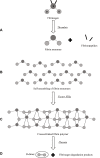D-Dimer Tests in the Emergency Department: Current Insights
- PMID: 34795538
- PMCID: PMC8593515
- DOI: 10.2147/OAEM.S238696
D-Dimer Tests in the Emergency Department: Current Insights
Abstract
In the Emergency Medicine setting, D-dimer is currently employed in the diagnostic assessment of suspected venous thromboembolism and aortic syndrome. The nonspecific symptoms reported by patients, like chest pain, dyspnea or syncope, uncover a wide range of differential diagnosis, spanning from mild to life-threatening conditions. Therefore, we assumed the perspective of the Emergency Physician and, in this narrative review, we reported a brief presentation of the epidemiology of these symptoms and the characteristics of patients, in whom we could suspect the aforementioned pathologies. We also reported in which patients D-dimer gives useful information. In fact, when the probability of the disease is high, the D-dimer level is futile. On the contrary, given the low specificity of the test, when the probability of the disease is very low, a false-positive value of the D-dimer only increases the risk of overtesting. Patients with low to moderate probability really benefit from the D-dimer testing, in order to prevent the execution of expensive and potentially dangerous imaging tests. In the second part of the review, we focused on the prognostic value of the test in septic patients. The early prognostic stratification of septic patients remains a challenge for the Emergency Physician, in the absence of a definite biomarker or score to rely on. Therefore, we need several parameters for the early identification of patients at risk of an adverse prognosis and the D-dimer may play a role in this demanding task. SARS COVID-19 patients represent an emerging reality, where the role of the D-dimer for prognostic stratification could be relevant. In fact, in patients with severe forms of this disease, the D-dimer reaches very high values, which appear to parallel the course of respiratory failure. Whether the test may add useful information for the management of these patients remains to be determined.
Keywords: COVID-19; aortic syndromes; diagnostic assessment; prognostic stratification; sepsis; venous thromboembolism.
© 2021 Innocenti et al.
Conflict of interest statement
The authors report no conflicts of interest in this work.
Figures





References
Publication types
LinkOut - more resources
Full Text Sources
Miscellaneous

